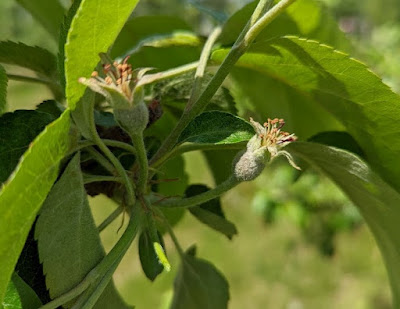 |
| Zestar! apple fruitlets in Minnetrista, MN on 6/1/2022. |
Author: Annie Klodd, Extension Educator - Fruit Production. kloddann@umn.edu
Apples
After a lot of apple scab infection events over the last couple of weeks, I am looking forward to a stretch without rain. We are post-petal fall now, and it's time to support those fruitlets as they grow. In Minnetrista, we are observing large crop loads on most varieties and will be applying a mild chemical thinner this week. We will re-evaluate a week later to decide whether to apply another.
Chemical thinning: This is a great time to apply a chemical thinner. So as not to re-invent the wheel, I recommend reading this article by UW-Madison on chemical thinning products.
Codling moth: Currently detected in Chaska - the first trap catch of the first generation of codling moths has been detected at the Horticultural Research Center in Chaska, MN via pheromone traps. It is time to set out codling moth pheromone traps. Washington State University suggests two methods for deciding when to spray. The easier of the two methods is to spray once 2 moths are caught in a single trap for 2 weeks in a row, using at least 1 trap per 2.5 acres. Read this article for more information.
 |
| Apple maggot and codling moth traps at an orchard in Minnetrista, MN, 6/1/2022. |
Plum curculio: Typically emerges around petal fall or 375 growing degree days base 50F. In Chaska today, we are at 376 GGD. For those looking toward a petal fall spray this week, include an insecticide with strong efficacy on plum curculio. There are several options listed in the Midwest Fruit Pest Management Guide, including Assail, Belay, Mustang Maxx, Permethrin, and Exirel, among others. Several of those will also control codling moth.
Use the NEWA network when making decisions on spray timing for insect and disease pests.
Grapes
 |
| Itasca shoots reaching a foot long on 6/2/2022 in Chanhassen, MN |
The optimal window for shoot thinning is coming to a close in southern MN as shoots exceed 10 inches long. Shoot thinning after this period is still better than not thinning at all; however, removing the shoots after that point will require pruning shears. As mentioned in the last two weekly updates, a simple rule of thumb is to thin to 2 shoots per spur, or 6-7 shoots per linear foot of cordon.
Phylloxera: You may have begun to see small galls on leaves, if phylloxera is present in your vineyard. Start scouting for phylloxera around 450 GGD; we are currently at 376 GGD in Chaska, MN.
Minor foliar phylloxera infestations do little harm, and may not be worth the cost to spray. Think of it this way: We are always thinning, pruning, and hedging to remove extra leaves. Therefore, should we lose sleep over a few infested leaves? It is true that controlling phylloxera early will prevent it from getting out of hand, but a few galls are no reason to panic. Decide what your personal tolerance is, and spray after you reach that threshold. More information.
Diseases: Infections of phomopsis and black rot were likely after this week's rainfall. If you did not apply a protective fungicide before the rain, consider applying a "kickback" application of an effective curative fungicide with efficacy for both phomopsis and black rot. Some examples include Luna Experience, Reason 500SC, or Ziram 76DF. Consult the Midwest Fruit Pest Management Guide for further options.
Strawberries
June-bearing strawberries: Fruit have started to form in many strawberry fields. Farms in far southern Minnesota may be seeing the first few ripe fruit on early varieties this week. Continue to monitor for tarnished plant bug, and spray for botrytis gray mold and anthracnose following wet, cool weather.
Day neutral strawberries: Currently, experts widely recommend
removing flowers for 4 weeks following planting. If you planted in
mid-May, you are still encouraged to continue flower removal for another
couple of weeks. This is thought to foster larger and more consistent
yields over the season, while not removing leaves may cause a flush of
fruit followed by a long slow period as the plants recover.
Botrytis: The rainy and cool conditions this past week were conducive for botrytis. It is most economical to apply a protectant fungicide prior to a rain event, but a systemic fungicide such as Pristine, Switch, Merivon, Elevate, and others can help stop existing infections if the opportunity is missed to apply a protectant. More information.
Tarnished Plant Bug: Refer to last week's update for information on tarnished plant bug.
Raspberries
 |
| Floricanes in a trial plot of 'Crimson Treasure' raspberries in Chanhassen, MN, 6/2/22 |
If spur blights, rusts, or powdery mildew have been a problem in recent years, or if they are observed, the pre-bloom period is a good time to spray for them, weather-dependent. Botrytis applications are not necessary until bloom.
If you suspect a problem or would like more information, email a photo to kloddann@umn.edu.
Tart Cherries
 |
| Northstar tart cherry is currently pea-sized in Chanhassen, MN, 6/2/2022 |
Tart cherries are pea-sized right now. You may start to notice small black spots on the berries, which could be from plum curculio. If you suspect a problem or would like more information, email a photo to kloddann@umn.edu.
Comments
Post a Comment